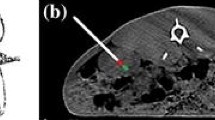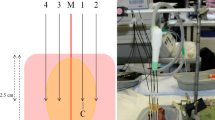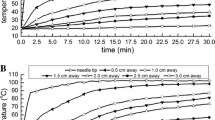Abstract
Purpose
To evaluate whether thermoreversible poloxamer 407 15.4 % in water (P407) can protect non-target tissues adjacent to microwave (MW) ablation zones in a porcine model.
Materials and Methods
MW ablation antennas were placed percutaneously into peripheral liver, spleen, or kidney (target tissues) under US and CT guidance in five swine such that the expected ablation zones would extend into adjacent diaphragm, body wall, or bowel (non-target tissues). For experimental ablations, P407 (a hydrogel that transitions from liquid at room temperature to semi-solid at body temperature) was injected into the potential space between target and non-target tissues, and the presence of a gel barrier was verified on CT. No barrier was used for controls. MW ablation was performed at 65 W for 5 min. Thermal damage to target and non-target tissues was evaluated at dissection.
Results
Antennas were placed 7 ± 3 mm from the organ surface for both control and gel-protected ablations (p = 0.95). The volume of gel deployed was 49 ± 27 mL, resulting in a barrier thickness of 0.8 ± 0.5 cm. Ablations extended into non-target tissues in 12/14 control ablations (mean surface area = 3.8 cm2) but only 4/14 gel-protected ablations (mean surface area = 0.2 cm2; p = 0.0005). The gel barrier remained stable at the injection site throughout power delivery.
Conclusion
When used as a hydrodissection material, P407 protected non-targeted tissues and was successfully maintained at the injection site for the duration of power application. Continued investigations to aid clinical translation appear warranted.





Similar content being viewed by others
References
Bodily KD, Atwell TD, Mandrekar JN et al (2010) Hydrodisplacement in the percutaneous cryoablation of 50 renal tumors. AJR Am J Roentgenol 194(3):779–783
Brace CL, Laeseke PF, Sampson LA, Frey TM, Mukherjee R, Lee FT Jr (2007) Radiofrequency ablation with a high-power generator: device efficacy in an in vivo porcine liver model. Int J Hyperth 23(4):387–394
Brace CL, Sampson LA, Hinshaw JL, Sandhu N, Lee FT Jr (2009) Radiofrequency ablation: simultaneous application of multiple electrodes via switching creates larger, more confluent ablations than sequential application in a large animal model. J Vasc Interv Radiol 20(1):118–124
Chang EI, Galvez MG, Glotzbach JP et al (2011) Vascular anastomosis using controlled phase transitions in poloxamer gels. Nat Med 17(9):1147–1152
Chen EA, Neeman Z, Lee FT, Kam A, Wood B (2006) Thermal protection with 5 % dextrose solution blanket during radiofrequency ablation. Cardiovasc Interv Radiol 29(6):1093–1096
Clark TW, Malkowicz B, Stavropoulos SW et al (2006) Radiofrequency ablation of small renal cell carcinomas using multitined expandable electrodes: preliminary experience. J Vasc Interv Radiol 17(3):513–519
Dumortier G, Grossiord JL, Agnely F, Chaumeil JC (2006) A review of poloxamer 407 pharmaceutical and pharmacological characteristics. Pharm Res 23(12):2709–2728
Durick NA, Laeseke PF, Broderick LS et al (2008) Microwave ablation with triaxial antennas tuned for lung: results in an in vivo porcine model. Radiology 247(1):80–87
Farrell MA, Charboneau JW, Callstrom MR, Reading CC, Engen DE, Blute ML (2003) Paranephric water instillation: a technique to prevent bowel injury during percutaneous renal radiofrequency ablation. AJR Am J Roentgenol 181(5):1315–1317
Goldberg SN, Ahmed M, Gazelle GS et al (2001) Radio-frequency thermal ablation with NaCl solution injection: effect of electrical conductivity on tissue heating and coagulation-phantom and porcine liver study. Radiology 219(1):157–165
Haemmerich D, Staelin ST, Tungjitkusolmun S, Lee FT Jr, Mahvi DM, Webster JG (2001) Hepatic bipolar radio-frequency ablation between separated multiprong electrodes. IEEE Trans Bio-med Eng 48(10):1145–1152
Hasegawa T, Takaki H, Miyagi H et al (2013) Hyaluronic acid gel injection to prevent thermal injury of adjacent gastrointestinal tract during percutaneous liver radiofrequency ablation. Cardiovasc Interv Radiol 36(4):1144–1146
Hines-Peralta AU, Pirani N, Clegg P et al (2006) Microwave ablation: results with a 2.45-GHz applicator in ex vivo bovine and in vivo porcine liver. Radiology 239(1):94–102
Hinshaw JL, Laeseke PF, Winter TC 3rd, Kliewer MA, Fine JP, Lee FT Jr (2006) Radiofrequency ablation of peripheral liver tumors: intraperitoneal 5 % dextrose in water decreases postprocedural pain. AJR Am J Roentgenol 186(5 Suppl):S306–S310
Hiraki T, Gobara H, Shibamoto K et al (2011) Technique for creation of artificial pneumothorax for pain relief during radiofrequency ablation of peripheral lung tumors: report of seven cases. J Vasc Interv Radiol 22(4):503–506
Institute of Laboratory Animal Resources CoLS, National Research Council (1996) Guide for the care and use of laboratory animals. National Academy Press, Washington, DC
Johnson A, Sprangers A, Cassidy P et al (2013) Design and validation of a thermoreversible material for percutaneous tissue hydrodissection. Journal of biomedical materials research Part B
Kamusella P, Wiggermann P, Wissgott C, Andresen R, Stroszczynski C (2011) Thermal protection of targeted air instillation in CT-guided radiofrequency ablation. RoFo : Fortschritte auf dem Gebiete der Rontgenstrahlen und der Nuklearmedizin 183(10):952–955
Knavel EM, Hinshaw JL, Lubner MG et al (2012) High-powered gas-cooled microwave ablation: shaft cooling creates an effective stick function without altering the ablation zone. AJR Am J Roentgenol 198(3):W260–W265
Laeseke PF, Lee FT Jr, van der Weide DW, Brace CL (2009) Multiple-antenna microwave ablation: spatially distributing power improves thermal profiles and reduces invasiveness. J Interv Oncol 2(2):65–72
Liang P, Wang Y, Yu X, Dong B (2009) Malignant liver tumors: treatment with percutaneous microwave ablation–complications among cohort of 1,136 patients. Radiology 251(3):933–940
Liang P, Yu J, Yu XL et al (2012) Percutaneous cooled-tip microwave ablation under ultrasound guidance for primary liver cancer: a multicentre analysis of 1,363 treatment-naive lesions in 1,007 patients in China. Gut 61(7):1100–1101
Lin T, Wu J, Zhao X et al (2014) In situ floating hydrogel for intravesical delivery of adriamycin without blocking urinary tract. J Pharm Sci 103(3):927–936
Livraghi T, Meloni F, Solbiati L, Zanus G, Collaborative Italian Group using As (2012) Complications of microwave ablation for liver tumors: results of a multicenter study. Cardiovasc Interv Radiol 35(4):868–874
Lubner MG, Hinshaw JL, Andreano A, Sampson L, Lee FT Jr, Brace CL (2012) High-powered microwave ablation with a small-gauge, gas-cooled antenna: initial ex vivo and in vivo results. J Vasc Interv Radiol 23(3):405–411
Oshima F, Yamakado K, Nakatsuka A, Takaki H, Makita M, Takeda K (2008) Simultaneous microwave ablation using multiple antennas in explanted bovine livers: relationship between ablative zone and antenna. Radiat Med 26(7):408–414
Park BK, Kim CK (2008) Using an electrode as a lever to increase the distance between renal cell carcinoma and bowel during CT-guided radiofrequency ablation. Eur Radiol 18(4):743–746
Pec EA, Wout ZG, Johnston TP (1992) Biological activity of urease formulated in poloxamer 407 after intraperitoneal injection in the rat. J Pharm Sci 81(7):626–630
Rossi S, Buscarini E, Garbagnati F et al (1998) Percutaneous treatment of small hepatic tumors by an expandable RF needle electrode. AJR Am J Roentgenol 170(4):1015–1022
Schmolka IR, Schmolka IR (1972) Artificial skin. I. Preparation and properties of pluronic F-127 gels for treatment of burns. J Biomed Mater Res 6(6):571–582
Shyn PB, Mauri G, Alencar RO et al (2014) Percutaneous imaging-guided cryoablation of liver tumors: predicting local progression on 24-hour MRI. AJR, American journal of roentgenology
Singh-Joy SD, McLain VC (2008) Safety assessment of poloxamers 101, 105, 108, 122, 123, 124, 181, 182, 183, 184, 185, 188, 212, 215, 217, 231, 234, 235, 237, 238, 282, 284, 288, 331, 333, 334, 335, 338, 401, 402, 403, and 407, poloxamer 105 benzoate, and poloxamer 182 dibenzoate as used in cosmetics. Int J Toxicol 27(Suppl 2):93–128
Yamakado K, Nakatsuka A, Akeboshi M, Takeda K (2003) Percutaneous radiofrequency ablation of liver neoplasms adjacent to the gastrointestinal tract after balloon catheter interposition. J Vasc Interv Radiol 14(9 Pt 1):1183–1186
Young JL, McCormick DW, Kolla SB et al (2012) Are multiple cryoprobes additive or synergistic in renal cryotherapy? Urology 79(2):484 e481–484 e486
Yu J, Liang P, Yu XL et al (2014) US-guided percutaneous microwave ablation versus open radical nephrectomy for small renal cell carcinoma: intermediate-term results. Radiology 270(3):880–887
Zhao YZ, Lv HF, Lu CT et al (2013) Evaluation of a novel thermosensitive heparin-poloxamer hydrogel for improving vascular anastomosis quality and safety in a rabbit model. PLoS ONE 8(8):e73178
Acknowledgments
The authors thank Lisa Sampson, M.S.; Alice Minx, B.Sc.; Thomas Warner, M.D., and Jeffrey Wu for their help with experimental setup.
Conflict of interest
The MW ablation system and P407 gel used in this study incorporate aspects of multiple patents pending. No industrial support was provided for this study. Four authors of this study have affiliations with NeuWave Medical, Inc, all of which are outside the submitted work: Anna J. Moreland is a consultant; J. Louis Hinshaw is a member of the medical advisory board and shareholder; Fred T. Lee Jr. is a patent holder, member of the board of directors, and shareholder; and Christopher L. Brace is a founder, shareholder, and consultant. Meghan G. Lubner, Timothy J. Ziemlewicz, Douglas R. Kitchin, and Alexander D. Johnson have no conflict of interest.
Funding Sources
NIH R01CA142737, R01CA149379; Wisconsin Alumni Research Foundation Technology Development program.
Statement of Animal Rights
All applicable institutional and/or national guidelines for the care and use of animals were followed.
Author information
Authors and Affiliations
Corresponding author
Rights and permissions
About this article
Cite this article
Moreland, A.J., Lubner, M.G., Ziemlewicz, T.J. et al. Evaluation of a Thermoprotective Gel for Hydrodissection During Percutaneous Microwave Ablation: In Vivo Results. Cardiovasc Intervent Radiol 38, 722–730 (2015). https://doi.org/10.1007/s00270-014-1008-9
Received:
Accepted:
Published:
Issue Date:
DOI: https://doi.org/10.1007/s00270-014-1008-9




